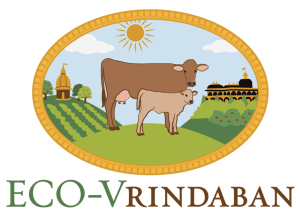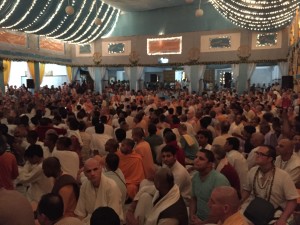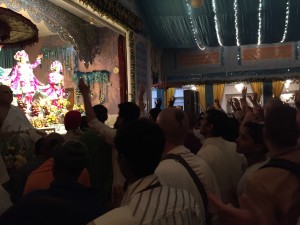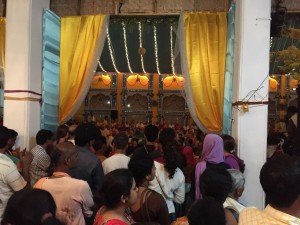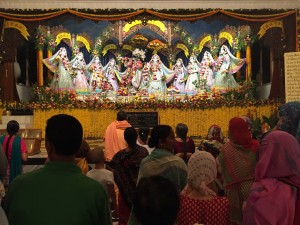Answer Podcast:
Who created God?
01 Mar 2015 – Amalaki Vrata Ekadashi
→ ISKCON Desire Tree
Jananivas Prabhu at ISKCON Mayapur on Jan 16th 2015
→ Gouranga TV - The Hare Krishna video collection
Jananivas Prabhu at ISKCON Mayapur on Jan 16th 2015, BG 11.09.11
Open Invitation to Weekend Activities in New Vrindaban: March 14 & 15, 2015
→ New Vrindaban Brijabasi Spirit
Dear Brijabasis,
Please accept my humble obeisances. All glories to Srila Prabhupada!
As we do twice a year, the board members of ISKCON New Vrindaban and ECO-Vrindaban are organizing a weekend of open presentations, discussions and tours.
We humbly invite all New Vrindaban residents and well-wishers to participate.
Weekend schedule:
Saturday, March 14th.
9:45 am to 1:30 pm: Department Head Presentations for 2015 (under the Lodge)
1:30 pm to 2:30 pm: Lunch Prasadam (at Radha Vrindaban Chandra’s Temple)
2:30 pm to 4:30 pm: Community Dialog (under the Lodge)
6:00 pm to 7:30 pm: Srila Prabhupada Sangam (at his Palace)
Sunday, March 15th.
10:00 am to 1:00 pm: New Vrindaban Parikram Tour (various locations around the Community)
1:00 pm to 3:00 pm: Sunday Program & Feast (at Radha Vrindaban Chandra’s Temple)
3:00 pm to 4:00 pm: Community Service Appreciations (under the Lodge)
We would be honored if you join us throughout the weekend and look forward to seeing you then.Hare Krishna!
Your servant,
Jaya Krsna das
ISKCON New Vrindaban Community President
HG Deva Darsana Prabhu / Bhagavad-gītā As It Is – Chapter Eleven: The Universal Form
→ Kalachandji's Audio Archive
HG Maha Hari Prabhu / SB 10.79.30-34
→ Kalachandji's Audio Archive
Gauranga Shata Nama 10 – The more we offer ourselves, the more the Lord reveals and charms us
→ The Spiritual Scientist
Holy Name Meditation Podcast:
Download by "right-click and save content"
CC daily 27 – M 4.97-101 – Deity is the living community center
→ The Spiritual Scientist
CC daily Podcast:
Download by "right-click and save content"
Kirtan Mela
→ Ramai Swami
Part of the Mayapur festival was dedicated to the Kirtan Mela and through out the day devotees assembled in the Panca Tattva temple hall for kirtan.
The path less traveled
→ KKSBlog
 I like to compare the taking of the initiation vows to a situation where the candidates are sitting in little boats in the ocean, and we are now preparing for take off.
I like to compare the taking of the initiation vows to a situation where the candidates are sitting in little boats in the ocean, and we are now preparing for take off.
So we are packing the boats. We say, “Here’s your instruction manual. Here’s your emergency kit. Whatever you need is in that little boat.” We are making sure that everything is there and you know how to use it all. That is what this talk basically is.
I Am Ultimately The One
→ Japa Group
Even when I can't really avoid all the work and responsibilities, still I am the one who is organizing those activities in a way that chanting often takes a back seat to the other things I do.
From www.harekrsna.de/artikel/japa-chanting.htm
Gita 05.23 – The war against lust is a war of attrition
→ The Spiritual Scientist
Gita Verse-by-verse Study Podcast
Download by "right-click and save content"
Bhagavatam-daily 132 – 11.09.04 – Even the ignorant can inspire seekers of the transcendent
→ The Spiritual Scientist
Bhagavatam-daily Podcast
Hare Krishna wedding in UK (4 min video)
Watch it here:…
→ Dandavats.com
Hare Krishna! Your invitation to the Open Vyasa-puja book
The…
→ Dandavats.com

Hare Krishna! Your invitation to the Open Vyasa-puja book
The book accepts offerings from everyone directly initiated by Srila Prabhupada. Every disciple who submits an offering will also receive a free copy of the book courtesy of the sponsorships the book receives. We are excited to launch a new online submission form this year. The new form will allow you to update your contact details anytime and submit your offering as a Word document attachment – please see www.sptributes.com for more details. This is a humble effort to increase our operational efficiency in creating the Tributes book by reducing the number of emails sent.
Read the entire article here: http://www.dandavats.com/?p=15758
Jnanagamya prabhu’s (ACBSP) earthly remains cremated and…
→ Dandavats.com

Jnanagamya prabhu’s (ACBSP) earthly remains cremated and his ashes scattered into the Ganga river.
Hare Krishna! Mothers glorified at Institute of Spiritual…
→ Dandavats.com

Hare Krishna! Mothers glorified at Institute of Spiritual Culture
The event focused on importance of mothers in a Krsna conscious society. First of all, sanyasis enlivened the audience with their words of wisdom. HH Candra Mauli Maharaj emphasized that women should be honored and respected for a happy society. Next, HH Bhakti Purusottama Maharaj told that women are greater than men in a different way. They control husband and children with their loving nature but not by externally showing themselves as masters. He shared an example that ladies serve all and then had food, this way they gained respect of other family members.
Read the entire article here: http://www.dandavats.com/?p=15755
Day 3 of Nabadwip Mandal parikrama
→ Mayapur.com
Gauraangaaaaaaa! On the third day (24th Feb) the Parikrama headed to Madhyadvipa, the island of Smaranam ( remembering). The first Holy place visited was Hamsa Vahana, where the devotees prayed for eagerness to Lord Shiva. Then the Parikrama reached Naimisaranya where Guru Puja was held. This was followed up with speeches by HG Pankajanghri […]
The post Day 3 of Nabadwip Mandal parikrama appeared first on Mayapur.com.
Kirtan with Madhava
→ Welcome to the official site of ISKCON Perth
Mothers glorified at Institute of Spiritual Culture
→ Mayapur.com
On 22nd February evening, there was an event ‘Celebrating the glories of our mothers‘ at Institute of Spiritual Culture, Mayapur. The event focused on importance of mothers in a Krsna conscious society. First of all, sanyasis enlivened the audience with their words of wisdom. HH Candra Mauli Maharaj emphasized that women should be honored […]
The post Mothers glorified at Institute of Spiritual Culture appeared first on Mayapur.com.
Srila Prabhupada’s parikrama in Vrindavana (Album 38…
→ Dandavats.com
Kirtan on evening of Feb 24th, Mayapura
→ SivaramaSwami.com
The post Kirtan on evening of Feb 24th, Mayapura appeared first on SivaramaSwami.com.
Hare Krishna! Introducing My Children to Vrndavana
I remember my…
→ Dandavats.com

Hare Krishna! Introducing My Children to Vrndavana
I remember my first impressions of Vrndavana. The historic temples, the many pilgrims, and the ubiquitous calls of “Jaya Radhe!” (“All glories to Krsna’s most beloved Srimati Radharani”) deeply impressed me with the veracity of my newly adopted Vaisnava practices. Will Vrndavana affect my very independent-minded daughters in the same way? I have three days to show them the Vrndavana I love. It’s hard to believe how much Vrndavana has changed since 1975. Vrndavana then had few amenities for visitors and devotees. Srila Prabhupada’s newly constructed Krishna-Balaram Temple rose high above the quiet, surrounding ashrams on their spacious lots with bird-laden trees. A rural atmosphere prevailed. Not so now.
Read the entire article here: http://www.dandavats.com/?p=15752
Hare Krishna! Remember God? Coming Back to My Eternal…
→ Dandavats.com

Hare Krishna! Remember God? Coming Back to My Eternal Friend
Over the years, I have served the Lord’s deity form, dressing Him, cooking for Him, making garlands and clothes for Him. I have also chanted His name in the streets, my baby daughter on my back, while distributing cookies I baked so others could have their first taste of prasadam. I have sent Srila Prabhupada’s books to all the prisons of Canada that were willing to accept them, and corresponded with many inmates, sending them more books and also prayer beads, encouraging them to take up the chanting of the holy name. I have organized Krishna conscious plays and taken part in a devotee home-school cooperative.
Read the entire article here: http://www.dandavats.com/?p=15749
Message from the GBC Chairman: 2015 Year of the TOVP
→ ISKCON News

In a gesture expressing unity of purpose for the service of ISKCON Founder-Acharya, A.C. Bhaktivedanta Swami Prabhupada, Praghosa Das, the newly appointed Chairman of the GBC, has announced in Mayapur that 2015, the 50th anniversary of Srila Prabhupada’s arrival in the Western world, is the Year of the TOVP.
Meet the highly qualified, expert and devoted professionals who…
→ Dandavats.com

Meet the highly qualified, expert and devoted professionals who are producing the most accurate and extensive movie about the history of Srila Prabhupada’s life: “Acharya”
Yadubara prabhu (John Griesser) is the Executive Producer and Director.
Photographer and filmmaker since 1970 who, along with his wife Visakha dasi, produced the early films for ISKCON, including Your Ever Well-Wisher, Hare Krishna People, Vrindavan—Land of Krishna and The Spiritual Frontier. More recently, the team produced “Following Srila Prabhupada,” a 31-hour video series on A.C. Bhaktivedanta Swami Prabhupada. Srila Prabhupada instructed Yadubara das to never put down his camera and to make Krishna conscious films the most popular films.
Read the entire article here: http://goo.gl/rJohOY
Potential Spouse: The Real Knight in the Shining Armor
→ ISKCON News
Srila Prabhupada Disciple Profile
Ragatmika Dasi concluded that…
→ Dandavats.com

Srila Prabhupada Disciple Profile
Ragatmika Dasi concluded that the goal of life was to “merge with the totality of spirit.” However, not wanting to achieve liberation alone, she wished to share her new-found discoveries with her friends. In pursuance of meeting them, she had a timely meeting with Bhuta Bhavana das on the subway in 1971, who told her that “Buddhists want to go home alone, but devotees of Krishna want to take others with them.” This resonated deeply with her. He invited her to the Sunday Love Feast the next day. Having previously gotten a BTG in Central Park, wherein there was an article describing the four regulative principles of freedom, which had appealed to her, she felt she had nothing left to do in this world but go to that Sunday feast. At the Brooklyn Temple, hearing the Panca Tattva mantra brought tears to her eyes. The story of “Liquid Beauty” also impressed her. When it came to honoring prasadam, she not only ate the prasadam from her own plate, but also the remnants from all the other plates at the Sunday program, disregarding her identification as a macrobiotic. She finally felt “at home.” The next day (4th of July) she was in a sari on Jones Beach, distributing BTG’s with the devotees.
Read the entire article here: http://goo.gl/jch4Gx
Day 5 of the ISKCON GBC Meetings Focuses on ISKCON’s 50th Anniversary
→ ISKCON News

The fifth day of the Annual General Meeting of ISKCON’s Governing Body Commission focused on celebrating the 50th anniversary of ISKCON’s incorporation in 2016. Pancaratna Dasa, a member of the 50th Anniversary International Steering Committee, presented an elaborate report on the progress made so far along with the list of events being planned.
Navadwip Mandal Parikrama 4th Day (Album 14 photos)
Srila…
→ Dandavats.com

Navadwip Mandal Parikrama 4th Day (Album 14 photos)
Srila Prabhupada: “Whatever state of being one remembers when he quits his body, that state he will attain without fail.” If one practices chanting the Hare Krishna mantra, he is naturally expected to chant Hare Krishna when he meets with some accident. Even without such practice, however, if one somehow or other chants the holy name of the Lord (Hare Krishna) when he meets with an accident and dies, he will be saved from hellish life after death.
(Srimad-Bhagavatam, 6.2.15 Purport)
See them here: http://goo.gl/Zd3CQp
Lecture by HH Candramauli Swami on S.B. 6.4.15-17
→ Mayapur.com
On 22nd February, HH Candramauli Swami gave lecture on S.B. 6.4.15-17. Below is transcript of the lecture. HH Candramauli Swami: (Pranama Mantras) We are hearing about Daksa in this particular verse which begins somewhat of a different theme here. Daksa, in his previous manifestation as a Prajapti, committed a very serious offense. What was his position? […]
The post Lecture by HH Candramauli Swami on S.B. 6.4.15-17 appeared first on Mayapur.com.
Rasika Nam prabhu: From hippy to bhakta to departed soul. (4 min…
→ Dandavats.com

Rasika Nam prabhu: From hippy to bhakta to departed soul. (4 min video)
During the night from 23 to 24 February Rasika-nama Prabhu wonderful devotee, with the voice of a Gandharva, who has spent a lifetime performing Harinam left his body. He is remembered by many for his wonderful kirtans at Navadvipa Mandala Parikrama 2014. He was like a Vishnuduta with a constant smile, carrying on his shoulder an accordion, always singing the holy name with enthusiasm and faith!.
During a Harinam Rasika-nama Prabhu (while he was leading it) became ill and he was taken to the hospital for “emergency” with a suspected heart attack, and that same night he went to Krishna. Rasika-nama Prabhu left the body, looking at Prabhupada, with his japa mala in his hands, and while he was conscious. He told the doctor that Prabhupada is our spiritual master. He was 32. Rasika-nama prabhu ki jaya! Srila Prabhupada ki jaya!
Watch it here: http://goo.gl/Wq4Bnx
Lecture by HH Sivarama Swami on SB 6.4.24
→ Mayapur.com
On 24th February, HH Sivarama Swami gave a lecture on SB 6.4.24 . Below is the transcription of the lecture. Hare Krishna! (repeats translation) (invocation prayers) These Hamsa-guhya prayers are, as Srila Prabhupada earlier said, they are already existing Vedic prayers, they had already been assimilated by Daksa at some previous, earlier time. If you remember that […]
The post Lecture by HH Sivarama Swami on SB 6.4.24 appeared first on Mayapur.com.
February 25th, 2015 – Darshan
→ Mayapur.com
The post February 25th, 2015 – Darshan appeared first on Mayapur.com.
Power Of Devotional Service – Murlidhar Prabhu
→ Gouranga TV - The Hare Krishna video collection
Power Of Devotional Service – Murlidhar Prabhu
class
Gaura Purnima Celebration in New Vrindaban March 5, 2015
→ New Vrindaban Brijabasi Spirit
Everyone is invited to GAURA PURNIMA FESTIVAL in New Vrindaban.
Thursday March 5, 2015
5:00 AM MANGAL ARATI
5:30 AM NRSIMHA PRAYERS
5:45 AM TULASI PRAYERS
6:00 AM JAPA
7:30 AM GURU PUJA
8:00 AM GREETING THE DEITIES
8:20 AM SRIMAD BHAGAVATAM CLASS
11:00 AM GOVARDHAN PARIKRAMA ( weather permitting)
1:00 PM ARATI
1:30 PM CLASS
2:15 PM *Lunch Prasadam (for those who are not fasting)*
2:30 PM GAURANGA BHAJANS
4:00 PM Special Presentation by Sankirtan das:How & Why the Hare Krsna Mantra Came West
5:00 PM ABHISHEKA ON THE ALTAR
6:00 PM LECTURE BY HIS HOLINESS VARSANA SWAMI
7:00 PM ARATI
7:40 PM MAHA KIRTAN
8:00 PM PRASADAM FEAST
Your preparations for the Lord are welcome. Please bring them by 5:45 PM. Thank you!
HG Narottamananda Prabhu / Kalachandji’s Bhagavad-Gītā Meditation Course – 42
→ Kalachandji's Audio Archive
Gaura Purnima Festival March 5, 2015 in New Vrindaban
→ New Vrindaban

Everyone is invited to come and help celebrate the auspicious Appearance Day of Lord Sri Caitanya Mahaprabhu, incarnation of the Lord, the original propagator of kirtan- chanting the Holy Names of the Lord.
He taught that anyone—regardless of background or spiritual qualification—could develop their innate love of God and experience great spiritual pleasure by chanting the Hare Krishna mantra.
GAURA PURNIMA SCHEDULE Thursday March 5, 2015
5:00 AM MANGAL ARATI
5:30 AM NRSIMHA PRAYERS
5:45 AM TULASI PRAYERS
6:00 AM JAPA
7:30 AM GURU PUJA
8:00 AM GREETING THE DEITIES
8:20 AM SRIMAD BHAGAVATAM CLASS
11:00 AM GOVARDHAN PARIKRAMA ( weather permitting)
1:00 PM ARATI
1:30 PM CLASS
2:15 PM *Lunch Prasadam (for those who are not fasting)*
2:30 PM GAURANGA BHAJANS
4:00 PM Special Presentation by Sankirtan das:How & Why the Hare Krsna Mantra Came West
5:00 PM ABHISHEKA ON THE ALTAR
6:00 PM LECTURE BY HIS HOLINESS VARSANA SWAMI
7:00 PM ARATI
7:40 PM MAHA KIRTAN
8:00 PM PRASADAM FEAST
Your preparations for the Lord are welcome. Please bring them by 5:45 PM. Thank you!
Giriraj Swami Japa Q&A
→ Japa Group
Krsna as bhakta vatsala
→ KKSBlog
(Kadamba Kanana Swami, 16 January 2014, Bhaktivedanta Manor, England, Srimad Bhagavatam 9.10.21-22)
Devotees of Krsna have somewhat of a different mood than devotees of Lord Rama. Devotees of Rama are very strict about dharma as Lord Rama himself, was extremely strict with executing dharmic principles in this world, even to the point of abandoning Sita devi.
 From the other side, Krsna promises that he would not take up any weapon in Kuruksetra but in the middle of the battlefield, we see what happens. Bhisma, who is the best fighter, gives a bit of trouble to Krsna’s friend, Arjuna. And what do we see then? Immediately, Krsna abolishes his promise, just like that. He takes up the wheel of a chariot and storms at Bhisma, ready to kill him! Just see! He broke his promise just like that!
From the other side, Krsna promises that he would not take up any weapon in Kuruksetra but in the middle of the battlefield, we see what happens. Bhisma, who is the best fighter, gives a bit of trouble to Krsna’s friend, Arjuna. And what do we see then? Immediately, Krsna abolishes his promise, just like that. He takes up the wheel of a chariot and storms at Bhisma, ready to kill him! Just see! He broke his promise just like that!
Therefore, kaunteya pratijanih na me bhaktya pranasyati. “Declare it boldly, o Arjuna, that my devotee will never perish!” (Bhagavad-gita 9.31) Why Arjuna? Because nobody will believe Krsna, as he does not always keep his promises, as say the acharyas, but Arjuna is a man of his word and would not break it.
So we see that the principles of dharma are meant for this world. When the Supreme Personality of Godhead comes to show how to live in this world, then he displays the principles of dharma. But when the Supreme Personality of Godhead comes to show what it is like in the spiritual world, then he breaks all the rules of dharma, because his devotee is more important to him than his own reputation, and more important than dharma. He is ready to put his devotee before anything and that is Krsna, bhakta vatsala – one who places his devotee before anything and who is ready to fully dedicate himself to his devotee.
It is said that Krsna even takes the form that a devotee desires. Krsna is known as daksa – the one who is expert and who is fulfilling different purposes at the same time. So, as he was breaking his promise to show that he is even transcendental to dharma, he was also reciprocating with his devotee, Bhisma, with whom had the vira-rasa, the relationship of chivalry. So Bhisma was fighting with him, shooting arrows at Krsna and making wounds on his body, and Krsna took it as offerings of flowers. It is so amazing how Krsna reciprocates and takes the form that his devotee desires. It is so wonderful how the Lord becomes controlled by the desire of his devotee! That is Krsna! And that is why there are so many forms of the Lord, as each form reciprocates with devotees who have different moods.

